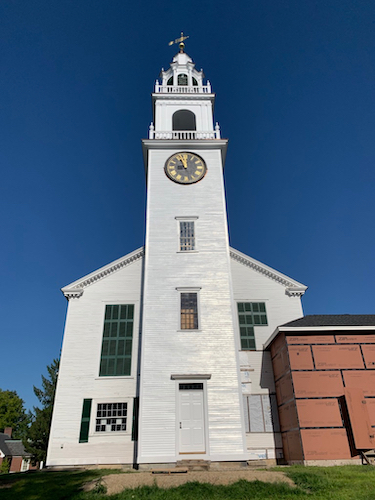“Best to remove farther off in the country”
On 3 Feb 1787, Sarah Cochran appeared before the Loyalists Commission in Saint John, New Brunswick.
She described how her husband John “went to Boston with Govr. [John] Wentworth” in late August 1775, as recounted here.
At the time, she and at least some of her children were living on the family farm in Londonderry. According to the Loyalist leader Abijah Willard, another commission witness, the Cochrans’ “Land was in a very good part of the Town, near the meeting house.“
(The picture here shows the First Parish Meetinghouse in Derry, New Hampshire, which might be the building Willard referred to. The oldest part of this church dates to 1769. It’s been significantly enlarged, and the impressive tower went up in 1822.)
Sarah Cochran testified that around October:
We know Sarah didn’t follow her husband into Boston that fall, or to Halifax and then New York the following year. Instead, the next sign of her appears in the 29 May 1777 Independent Chronicle of Boston, publishing an “Extract of a letter from John Cochran, on Long-Island, to his wife in New-Hampshire, intercepted with others sent by the late Governor Winthrop to his sister”:
In June 1779 the New Hampshire legislature moved to confiscate the property of men away from the state and “residing with the enemys thereof.” Its new law listed individual names starting with former governor Wentworth, Surveyor General Samuel Holland, and one-time Stamp Act administrator George Meserve. The fourth name was John Cochran.
TOMORROW: Serving the Crown.
She described how her husband John “went to Boston with Govr. [John] Wentworth” in late August 1775, as recounted here.
At the time, she and at least some of her children were living on the family farm in Londonderry. According to the Loyalist leader Abijah Willard, another commission witness, the Cochrans’ “Land was in a very good part of the Town, near the meeting house.“
(The picture here shows the First Parish Meetinghouse in Derry, New Hampshire, which might be the building Willard referred to. The oldest part of this church dates to 1769. It’s been significantly enlarged, and the impressive tower went up in 1822.)
Sarah Cochran testified that around October:
about 2 months after he went, she was ordered to quit the Premises, which she did & was moving her goods, on which a Mob rose & took every thing she had, calling them ye goods of a Tory. She got part back, but lost to amount of £150 lawful.Unfortunately for us, Sarah didn’t recount where she went. Possibly she took refuge with her own family, or even with other members of the Cochran clan who were siding with the rebels.
We know Sarah didn’t follow her husband into Boston that fall, or to Halifax and then New York the following year. Instead, the next sign of her appears in the 29 May 1777 Independent Chronicle of Boston, publishing an “Extract of a letter from John Cochran, on Long-Island, to his wife in New-Hampshire, intercepted with others sent by the late Governor Winthrop to his sister”:
My Dear,I don’t know why Cochran was so anxious about his wife giving refuge to a minister. It’s possible that the family was Presbyterian and feared their ministers would be suspected of disloyalty by New England Congregationalists.
I would willingly advise, but know not how or what to advise you to at this distance. I shall leave it intirely to your judgment what you think best to be done in these unhappy days, for I am so puzzled about giving my advice what to do, that I am almost crasy.
However, I think upon the whole, it would be best to remove farther off in the country, as I am afraid you will suffer where you are, before it will be in my power to protect you, as there will be nothing but destruction of property without any reserve. In that case, I would have you send off the most valuable effects you have left to some place, if you know of any.
I shall either hope to find you at the Isle Shoals, or up at Londonderry—If you intend to tarry where you are, I pray for God’s sake that there be no CLERGYMAN in the house; if their is, your life is not worth a farthing as the whole race of that tribe will be spilt.
If you see any prospect of the affairs being given up without bloodshed, I had rather find you at Hampton than any where else…
In June 1779 the New Hampshire legislature moved to confiscate the property of men away from the state and “residing with the enemys thereof.” Its new law listed individual names starting with former governor Wentworth, Surveyor General Samuel Holland, and one-time Stamp Act administrator George Meserve. The fourth name was John Cochran.
TOMORROW: Serving the Crown.


2 comments:
Connecticut governor Jonathan Trumbull sent a copy of John Cochran’s letter to his wife to Gen. George Washington on 10 Mar 1777, meaning it must have been written before then.
(This is different from the letters that the New Jersey Loyalist Richard Cochran and his wife Marion exchanged, discussed in another letter to Washington.)
I missed the opportunity to end this posting with the “Can this marriage be saved?” tag, but I never sensed any doubt.
Post a Comment